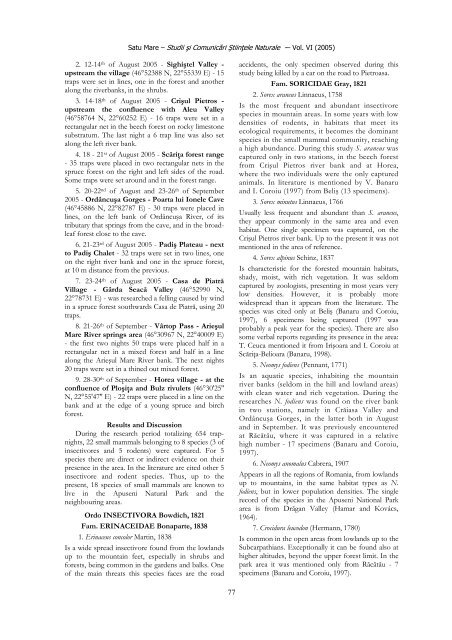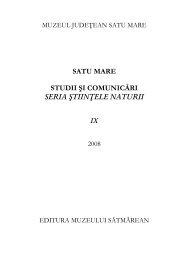Referenţi ştiinţifici - Muzeul Judeţean Satu Mare
Referenţi ştiinţifici - Muzeul Judeţean Satu Mare
Referenţi ştiinţifici - Muzeul Judeţean Satu Mare
You also want an ePaper? Increase the reach of your titles
YUMPU automatically turns print PDFs into web optimized ePapers that Google loves.
<strong>Satu</strong> <strong>Mare</strong> – Studii şi Comunicări Ştiinţele Naturale -– Vol. VI (2005)<br />
2. 12-14th of August 2005 - Sighiştel Valley -<br />
upstream the village (46°52388 N, 22°55339 E) - 15<br />
traps were set in lines, one in the forest and another<br />
along the riverbanks, in the shrubs.<br />
3. 14-18th of August 2005 - Crişul Pietros -<br />
upstream the confluence with Aleu Valley<br />
(46°58764 N, 22°60252 E) - 16 traps were set in a<br />
rectangular net in the beech forest on rocky limestone<br />
substratum. The last night a 6 trap line was also set<br />
along the left river bank.<br />
4. 18 - 21st of August 2005 - Scăriţa forest range<br />
- 35 traps were placed in two rectangular nets in the<br />
spruce forest on the right and left sides of the road.<br />
Some traps were set around and in the forest range.<br />
5. 20-22nd of August and 23-26th of September<br />
2005 - Ordâncuşa Gorges - Poarta lui Ionele Cave<br />
(46°45886 N, 22°82787 E) - 30 traps were placed in<br />
lines, on the left bank of Ordâncuşa River, of its<br />
tributary that springs from the cave, and in the broadleaf<br />
forest close to the cave.<br />
6. 21-23rd of August 2005 - Padiş Plateau - next<br />
to Padiş Chalet - 32 traps were set in two lines, one<br />
on the right river bank and one in the spruce forest,<br />
at 10 m distance from the previous.<br />
7. 23-24th of August 2005 - Casa de Piatră<br />
Village - Gârda Seacă Valley (46°52990 N,<br />
22°78731 E) - was researched a felling caused by wind<br />
in a spruce forest southwards Casa de Piatră, using 20<br />
traps.<br />
8. 21-26th of September - Vârtop Pass - Arieşul<br />
<strong>Mare</strong> River springs area (46°30967 N, 22°40009 E)<br />
- the first two nights 50 traps were placed half in a<br />
rectangular net in a mixed forest and half in a line<br />
along the Arieşul <strong>Mare</strong> River bank. The next nights<br />
20 traps were set in a thined out mixed forest.<br />
9. 28-30th of September - Horea village - at the<br />
confluence of Ploşiţa and Bulz rivulets (46°30'25''<br />
N, 22°55'47'' E) - 22 traps were placed in a line on the<br />
bank and at the edge of a young spruce and birch<br />
forest.<br />
Results and Discussion<br />
During the research period totalizing 654 trapnights,<br />
22 small mammals belonging to 8 species (3 of<br />
insectivores and 5 rodents) were captured. For 5<br />
species there are direct or indirect evidence on their<br />
presence in the area. In the literature are cited other 5<br />
insectivore and rodent species. Thus, up to the<br />
present, 18 species of small mammals are known to<br />
live in the Apuseni Natural Park and the<br />
neighbouring areas.<br />
Ordo INSECTIVORA Bowdich, 1821<br />
Fam. ERINACEIDAE Bonaparte, 1838<br />
1. Erinaceus concolor Martin, 1838<br />
Is a wide spread insectivore found from the lowlands<br />
up to the mountain feet, especially in shrubs and<br />
forests, being common in the gardens and balks. One<br />
of the main threats this species faces are the road<br />
77<br />
accidents, the only specimen observed during this<br />
study being killed by a car on the road to Pietroasa.<br />
Fam. SORICIDAE Gray, 1821<br />
2. Sorex araneus Linnaeus, 1758<br />
Is the most frequent and abundant insectivore<br />
species in mountain areas. In some years with low<br />
densities of rodents, in habitats that meet its<br />
ecological requirements, it becomes the dominant<br />
species in the small mammal community, reaching<br />
a high abundance. During this study S. araneus was<br />
captured only in two stations, in the beech forest<br />
from Crişul Pietros river bank and at Horea,<br />
where the two individuals were the only captured<br />
animals. In literature is mentioned by V. Banaru<br />
and I. Coroiu (1997) from Beliş (13 specimens).<br />
3. Sorex minutus Linnaeus, 1766<br />
Usually less frequent and abundant than S. araneus,<br />
they appear commonly in the same area and even<br />
habitat. One single specimen was captured, on the<br />
Crişul Pietros river bank. Up to the present it was not<br />
mentioned in the area of reference.<br />
4. Sorex alpinus Schinz, 1837<br />
Is characteristic for the forested mountain habitats,<br />
shady, moist, with rich vegetation. It was seldom<br />
captured by zoologists, presenting in most years very<br />
low densities. However, it is probably more<br />
widespread than it appears from the literature. The<br />
species was cited only at Beliş (Banaru and Coroiu,<br />
1997), 6 specimens being captured (1997 was<br />
probably a peak year for the species). There are also<br />
some verbal reports regarding its presence in the area:<br />
T. Ceuca mentioned it from Irişoara and I. Coroiu at<br />
Scăriţa-Belioara (Banaru, 1998).<br />
5. Neomys fodiens (Pennant, 1771)<br />
Is an aquatic species, inhabiting the mountain<br />
river banks (seldom in the hill and lowland areas)<br />
with clean water and rich vegetation. During the<br />
researches N. fodiens was found on the river bank<br />
in two stations, namely in Crăiasa Valley and<br />
Ordâncuşa Gorges, in the latter both in August<br />
and in September. It was previously encountered<br />
at Răcătău, where it was captured in a relative<br />
high number - 17 specimens (Banaru and Coroiu,<br />
1997).<br />
6. Neomys anomalus Cabrera, 1907<br />
Appears in all the regions of Romania, from lowlands<br />
up to mountains, in the same habitat types as N.<br />
fodiens, but in lower population densities. The single<br />
record of the species in the Apuseni National Park<br />
area is from Drăgan Valley (Hamar and Kovács,<br />
1964).<br />
7. Crocidura leucodon (Hermann, 1780)<br />
Is common in the open areas from lowlands up to the<br />
Subcarpathians. Exceptionally it can be found also at<br />
higher altitudes, beyond the upper forest limit. In the<br />
park area it was mentioned only from Răcătău - 7<br />
specimens (Banaru and Coroiu, 1997).




